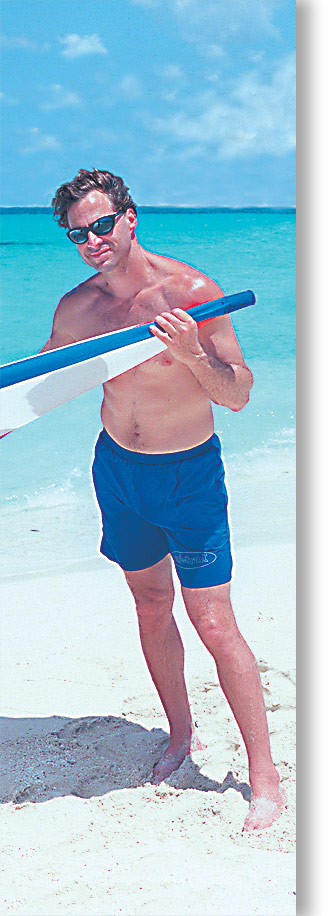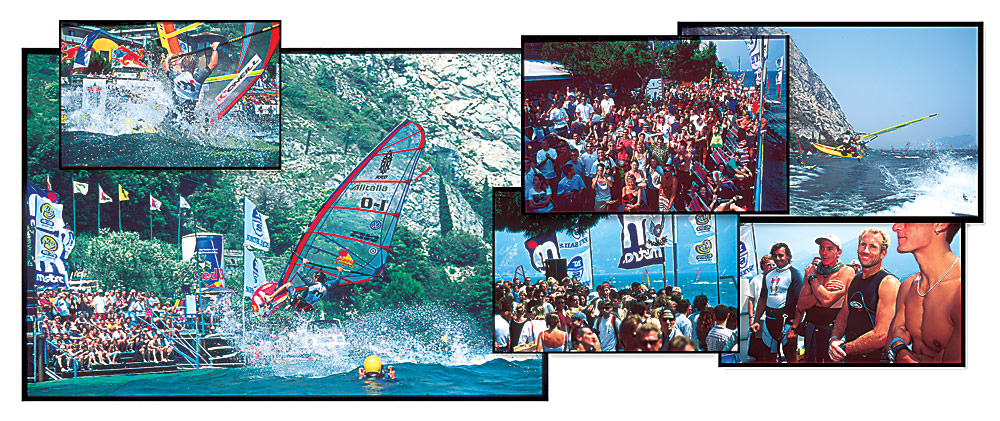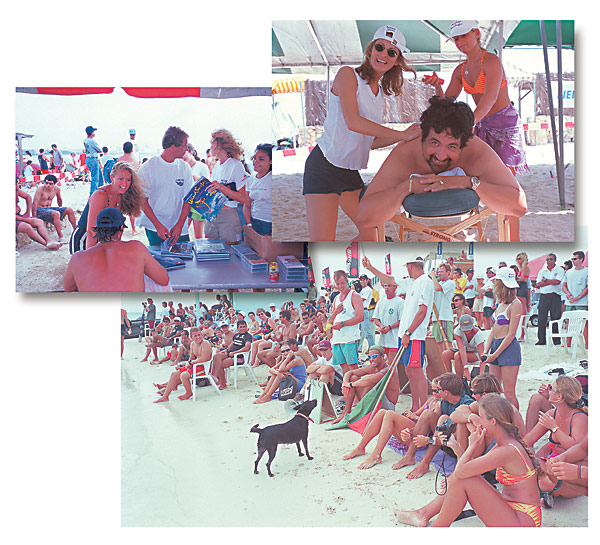
The Big Wave around the office lately is a new technical editor by the name of Ken Winner. Winner has been influencing the sport since the late seventies and is, to many, the foremost technical guru in the world. Ken Winner, US-1, invented the telescoping boom, foot-adjustable mast track, the WindGlider, the Anti-Ventilation Skirt now found on many race and freeride boards, and many other useful innovations. A former president of the USWA (now US Windsurfing), he developed the carving jibe back in early 1980 and a few years later wrote the first pro World Cup rules book.
The addition of Ken Winner to the American Windsurfer Team on July 1st, 1998, will have great implications for this magazine and the sport. With a three year contract, the signing of Winner is a major commitment to the future. “Ken brings with him the very foundation of what this sport is built on. He is a professional and the best technical editor in the world. What really impressed me are his visions and desire to make the future of this sport vibrant. I can’t think of a better person to compliment our efforts.” —John Chao, publisher/ editor of the magazine.
For Ken Winner, American WIndsurfer Magazine represents an opportunity to continue his efforts to bring windsurfing to a wider audience, while still working on projects designed to help high-end, high-performance windsurfers. Says Winner, “American Windsurfer and I share a vision of windsurfing as a sport that has something for everyone.”
Of course, Winner has already begun formulating plans for American Windsurfer’s 1999 product testing sessions, scheduled for Maui in October and Aruba in December.
American Windsurfer has arranged its tests to headquarter around two of the world’s best windsurfing locations. In Maui, we have settled on the plush Club Paradise mansion of Bill Fleischer near Kanaha. Its swimming pool, tennis court and grassy courtyard with access to the ocean will be the headquarters for the wave and high performance equipment testing. (See next page)
Guest testers interested in High wind, wave and bump conditions will be invited to join Winner in Maui for this first American Windsurfer test session. Booking can be made on three separate weeks starting on October 3rd and with a fourth and last week as a back up. Limited housing is available at the site on a first come first serve basis. Reservations can be made by calling 1-800-292-2772 for the main house. Off site rooms are available by calling Julie at Hawaiian Island Surf & Sport 1-800-231-6958, Greg at Second Wind 1-800-936-7787, or Marsh at Maui Windsurfari, 1-800-736-6284.
A second month of testing is scheduled for Aruba in December. Aruba will be the site for all the slalom, long board and beginner equipment tests. The Aruba session is open to all levels of sailors. The location for this test will be hosted by the world renowned Sailboard Vacations. (see next page) Reservations can be made by calling Charlie, at 1-800-252-1070 for any of the three weeks beginning December 12th, with a fourth week as a back-up.
Advertisement
American Windsurfer has made a special effort to elevate the status of the tests to NEW possibilities. The magazine will be there with its award winning staff which includes Darrell Jones, AW’s senior photographer. The commitment to produce landmark equipment test reports and to capture the social dynamics of the setting and the guest testers should be a winning combination. Balance is what this sport is all about, so get ready to hook in and hold on, the equilibrium has just changed—and the wind is freshening!
The wind stalled for the American team challenging the world on the TransAtlantic Windsurf Race (TAWR) that will begin on September 11 from New York City and crossing 2,900 in ten days to end in France.
While the lack of a pro-team might seem as a major loss to the country—an exciting and novel opportunity has surfaced. Because of the forfeit the slot that was previously taken up by the US pro-team is vacant and has been given over to American Windsurfer Magazine. We must form an AMATEUR team of 5 sailors. Yes, you can be part of this historical journey and join the likes of Björn Dunkerbeck, Anders Bringdal, Robert Teriitehau and the only other amateur team, from France.
The change of going to France rather than to England came about because of two reasons. The first was the money. The French town of les Sables d’Olonnes put up a considerable amount of money in an effort to draw the event to French soil. The port has been a historical finish line to many of the round the world races. The fact that 150,000 people turn out to greet these yachtsman made this port notable.
The other reason, which the organizers insist is the main reason for the change in destination, is the fact that the new route cut off three days of the trip and resolves a major scheduling problem for the pro-sailors. The World Cup event in Sylt Germany was to start on the 26th and the sailors would only have two days to recover after finishing the crossing in England.
The elite fleet of world class professional windsurfers will be escorted by a 400 foot Russian Ice breaker, the Kaptain Khlebnikov. The Khlebnikov has successfully traversed the Atlantic for 15 years, bringing hundreds of eco-tourists into the Arctic Circle, through some of the harshest conditions found on the planet. The mothership has been pressed into service by the TAWR organizers to serve as the race command center- the base for weather information, satellite uplinks, as well as offering a unique filming platform.
To keep track of the vulnerable racers in gale force winds and 40 to 50 foot waves, all sailors will be wearing global positioning satellite (GPS) transponders to monitor their positions and race progress as they cross the Atlantic. The sailors will be under the cover of the ship’s two Puma helicopters, along with ten 24 foot rigid inflatable boats, driven by military veterans who will launch, recover and pace each team as they traverse the Atlantic.
A world class technical support crew has been assembled to ensure that the racers survive the crossing. The TAWR support team has been hand-picked from seasoned veterans; crew members from the recently completed Whitbread Round the World Yacht Race, the Virgin Atlantic Crossing and the America’s Cup campaigns will all be present.
Five international teams of two professional windsurfers and two amateur teams of four will compete in a round robin format, from dawn to dusk. In case of injury or severe exhaustion each team has been allowed a back-up sailor. Each team had to cough up a whopping $50,000 entry fee to have the a slot at the starting line.
For the US Amateur Team, the cost per racer will be $8,000. Qualifying racers will be selected by Ken Winner and John Chao who will serve as team captains and will cover the event for the magazine and its web site. There are also 20 beds left for anyone who just want to be there for the ride (see following spread). The cost for the Adventure Holiday Package is $3,200 which includes an one-way ticket back from France to NYC.
Those wishing to apply for one of the four coveted racing positions or the last 15 VIP beds can call 1-603-293-2721 or email: amwind@lr.net.
Storms and high seas, along with sheer exhaustion, will make survival a real issue, as the windsurfers participating in this historical journey race for both themselves and the sport of windsurfing. Each team will battle the elements, their own fears, and each other in hope of bringing a new World Record home to their country.
Race Format: Official start and finish: The race is from Ambrose Light, New York to les Sables d’Olonnes, France. This is the famous “Blue Ribbon” Route. Ten days of racing across 2,900 nautical miles of the Atlantic Ocean. This averages out to approximately 290 miles of open ocean sailing per day. Perfect weather conditions could allow for the “24 hour Most Miles Logged” record to be broken.
Seven international teams with sophisticated safety coverage will windsurf from dawn to dusk. Night-vision instruments and shortened “Race Parameters” will control the night sailing. The sailors will be ferried from their team support vessels (rigid inflatables) to the mothership during the “off period”. This means sailors will stay fresher, healthier and able to push themselves for hours longer.
The daily routine, subject to weather conditions, will begin at 0400hrs continuing to around 2300hrs everyday. The racing will be done in “legs” of approximately 2-3 hours in duration with regulated “Tagging”of Team sailors during one hour change over periods. For example: 3hrs sailing (Sailor 1)—1hr change over—3hrs sailing (Sailor 2)—1hr change over—3hrs sailing (sailor 1) etc. Each sailor will average 7 hours of sailing each day. (approx 3hrs for amateurs) In Yachting terms, this is the equivalent of 3hrs on 5hrs off rolling shifts. Team sailors will be transported from their Team support Vessel to and from the Mothership for each leg. Two designated support vessels will act as ferry boats.
Statistics on the Race format:
• The Mothership- The 400 foot Russian Ice Breaker the “Kaptain Khlebnikov” will serve as the race and communication headquarters. She will be no more than 20 miles behind fleet and will catch up with the fleet during the 1hr change over breaks. Top speed 19 kts.
• Each Team will have its own designated 24 foot military style Rigid Inflatable Boat (RIB) with a 240hp inboard diesel engine. Each support boat will shadow its team members on the water, keeping them in visual contact.
• All the Team RIBs are specifically built to stand up to the punishment of open ocean pacing and will be driven by seasoned Royal Marine drivers.
• The RIB’s will be launched and recovered from the mothership by two cranes with sophisticated tension systems for safety.
• Sailors will go aboard the RIBs using two gang-ways, located on either side of the mothership, which rise and fall with the ocean swells, via a floating platform attached to a crane.
• Each sailor and RIB will have a GPS (Global Positioning System) satellite transmitter on them which will be monitored by the mothership at all times (accuracy 5 meters.)
• Each sailor will wear a helmet with built-in two-way radio headset communicator. At times sailors will need to wear helmets with built-in “Head-Cam’s.”
• The minimum wind limit is 6 knots and the maximum wind limit is variable, at the discretion of the safety committee, but will be approximately 30 knots. The maximum weather conditions for night sailing will usually be less than the day limit.
• The Maximum racing parameter during the day will be around 8 miles from the first to last position. At night this parameter will be greatly less. Teams falling too far behind will be retired from the leg and will start the next one new.
• Teams will be awarded points on positions finished for each and every leg of the race. Teams will also be timed for each leg.
• To enhance night sailing safety, Night-Vision instruments will be used by the safety committee. “Fire-Flies” will also be mounted to the top of the sailors’ helmets (intensive flashing lights), and the team’s support vessels will be in closer proximity, depending on the weather conditions.
• There will be two Puma helicopters stationed on the mothership.
• A Royal Marine doctor with full medical back-up will be provided.
Safety Committee: all experts in their field, made up of the following:
• Safety Officer: Richard Clifford—A Major in the SBS (Special Boat Service) division of the Royal Marines, retired from 30 years service in 1997. Richard is the most experienced and important member of the safety committee.
• Race Director: Bob Rice—TBC Weather Specialist works extensively on America’s Cup, Whitbread and Enza, and Virgin America’s Cup challenges.
• Medical Officer: Chris Reid—MBBS Surg Lt in the Royal Marines specialized in ATLS (Advanced Trauma Life Support.)
• RIB Officer: Russ Kerslake: An Ex-Royal Marine LCI SNCO’s – heavily experienced in extreme RIB handling and safety.
• Communications Officer: Jim Bruton—Working for Yale University and CNN as communication technology expert in extreme environments. He has sent live communications from Mt. Everest and from Ocean vessels.
Advertisement

Back to some earthly competitions. The Red Bull King of the Lake Freestyle Competition, now in its 3rd year, continues to produce some astounding windsurfing. Presented by North Sails and held at Hotel Pier on Lago di Garda in Italy, the event just keeps picking up speed.
This year’s competition, from June 18th to the 21st, featured some of the most exciting riders in the sport: Robby Naish, Björn Dunkerbeck, Josh Stone, Sean Ordonez, Robby Seeger, Vidar Voodoo Jensen, Jason Polakow, Nik Baker, Marcos Perez, and many others. The support of a flat-water event by such big names is representative of a growing interest in Freestyle windsurfing. The event staff refer to the sailing approach used on the lake as “Soul Surfing.”
On top of the technical differences, the King of the Lake competition approaches the sport with a new attitude, as well. That may be why the event draws thousands of spectators ranging from the die-hard windsurfer to the generic sports enthusiast. First of all, the event mixes music with the sailing and puts the spectators right on the water’s edge. In addition, the scoring system is based on overall impression rather than a rigid set of rules. This system encourages an all-out style that leaves the crowd sitting with their jaws on the floor. What this all adds up to is four days of fun, and that’s one subject the people in Lake Garda know all about.
Day 1: With the wind not cooperating for valid competition, contestants and spectators alike are forced to find alternate forms of entertainment. A huge dinner is held at an Italian (surprise) ristorante. Attendees include surfers and other VIPs. Ahh, but the night was still young and Italian lust was in the air– where else to go afterward but Ali Baba’s Discotheque?
Day 2: The contest is on! Thanks to dramatically improved weather conditions, the crowd can plan on an exciting day of sailing. The early heats showcase some of the local talent taking on the “Maui Gang.” What makes this day even more special is that it marks the first time that Robby Naish has ever competed in a freestyle event. He did not disappoint, pulling off a move he calls a “Gizz” and following it with a perfect air-jibe, the only one of the day. The spectacular moves pulled off on this first day of competition are too numerous to mention– let’s just say that the 19 heats finished that day prevented everyone from going to the bathroom.
Day 3: Four unbeaten surfers remain: Robby Naish, Robby Seeger, Jason Polakow and Nik Baker. The music wails as the four giants sail off to do battle. In the end, it was Robby who survived. But maybe not the one you expected– it was Robby Seeger and his backloop clew-first move that prevailed. And just when he thought he was the King, he had to face one more competitor: the lion-hearted Josh Stone. The fierce battle that ensued only served to prove beyond all doubt that Robby Seeger was indeed King of the Lake. The crowning later that night and the party that went with it is best left to the reader’s imagination.
Day 4: As if the competition wasn’t enough, the stars come out again to freestyle for fun. A large boat is driven to and fro to provide the waves necessary for some monster jumps. Again, the crowd gets a front row seat to one of the most spectacular shows in windsurfing.
What else can be said? The showmen of our sport got together at a very different venue and proved to everyone exactly why they deserved their recognition as the “world’s best.” Waves were most definitely made.

You probably guessed, the favorite and most accessible windsurfing location for this magazine is Aruba. Not only is it an “One Happy Island,” it is also conveniently windy and close to New Hampshire. So when the 11th Annual Hi-Winds kicked off this past June, we were there for the big beach party. Not only were we there to join the annual festivities that included a moonlight sail party, we just happened to bring two very attractive massage therapists. Kimbra Hickey, a budding windsurfer from the Big Apple and Margie Johnstone, a hardcore windchaser from the Bay Area agreed to serve as representatives of the official American Windsurfer Massage Therapy Team. Talk about MakingWaves in a sea of hard working, tissue ailing, muscle aching men! Need we say more?
Yes we do . . . for Kimbra Hickey the week of Hi-Winds not only furthered her skills treating adoring sailors standing in line—her improvement on the water was also dramatic with adoring instructors close by her side. At the final awards banquet, she was instantly drafted to be the trophy girl when Miss Aruba was found to be MIA. We weren’t surprised when she volunteered for future AW missions.

